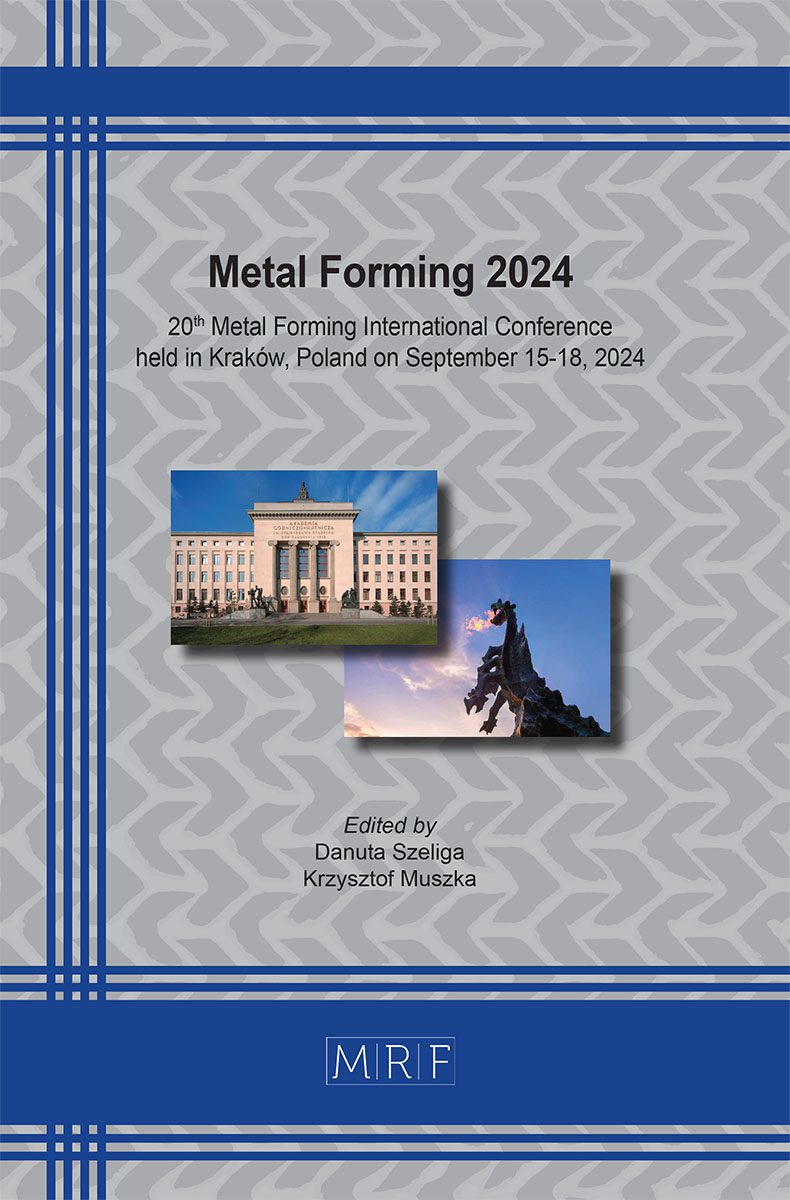–
Segmented blank holder concept to influence the forming zone during incremental bending
PANICK Daniel, FROHN-SÖRENSEN Peter, ENGEL Bernd
download PDFAbstract. Decreasing batch sizes and a simultaneous increase in the number of variants are developments in production technology that can no longer be managed economically using conventional mould technology with rigid, product-specific functional surfaces for semi-finished products. Individual or even in-line reconfigurations of the tool’s functional surfaces are being investigated to meet production requirements. Moreover, the goal is to control these surfaces during the process to compensate fluctuations, e.g. in semi-finished products. Incremental swivel bending (ISB) is a process for flexible bending forming in which the bending moment is transferred to the semi-finished product by friction by means of the clamping surfaces of the blank holder. In addition to the geometric and mechanical properties of the semi-finished product, the contact normal force and friction are responsible for the size and shape of the forming zone. In this paper, established analytics are utilized to present a tool concept that enables the clamping force distribution to be specifically adjusted by means of adjustable segmented hold-down surfaces with a vertical degree of freedom and, as a result, the size and shape of the forming zone to be influenced. The potential for extending the limits of forming technology is then discussed regarding the numerically determined local strain distribution through the dynamic loading and unloading of the clamping surface segments during incremental forming with the overall goal to achieve an in-process controllable material flow during sheet metal forming.
Keywords
Incremental Forming, Flexibility, Forming Zone, Adjustable Tools, Tool Segmentation, Profile Bending, Finite Element Method
Published online 9/15/2024, 11 pages
Copyright © 2024 by the author(s)
Published under license by Materials Research Forum LLC., Millersville PA, USA
Citation: PANICK Daniel, FROHN-SÖRENSEN Peter, ENGEL Bernd, Segmented blank holder concept to influence the forming zone during incremental bending, Materials Research Proceedings, Vol. 44, pp 271-281, 2024
DOI: https://doi.org/10.21741/9781644903254-30
The article was published as article 30 of the book Metal Forming 2024
![]() Content from this work may be used under the terms of the Creative Commons Attribution 3.0 license. Any further distribution of this work must maintain attribution to the author(s) and the title of the work, journal citation and DOI.
Content from this work may be used under the terms of the Creative Commons Attribution 3.0 license. Any further distribution of this work must maintain attribution to the author(s) and the title of the work, journal citation and DOI.
References
[1] D.Y. Yang, M. Bambach, J. Cao, J.R. Duflou, P. Groche, T. Kuboki et al, Flexibility in metal forming, CIRP Annals 67 (2018) 743–765. https://doi.org/10.1016/j.cirp.2018.05.004
[2] R. Rauter, D. Globocnik, E. Perl-Vorbach, R.J. Baumgartner, Open innovation and its effects on economic and sustainability innovation performance, J. Innov. Knowledge 4 (2019) 226–233. https://doi.org/10.1016/j.jik.2018.03.004
[3] Y. Wang, H.-S. Ma, J.-H. Yang, K.-S. Wang, Industry 4.0: a way from mass customization to mass personalization production, Adv. Manuf. 17 (2017) 311–320. https://doi.org/10.1007/s40436-017-0204-7
[4] J.M. Allwood, D.R. Shouler, A.E. Tekkaya, The Increased Forming Limits of Incremental Sheet Forming Processes, KEM 344 (2007) 621–628. https://doi.org/10.4028/www.scientific.net/KEM.344.621
[5] L. Filice, L. Fratini, F. Micari, Analysis of Material Formability in Incremental Forming, CIRP Annals 51 (2002) 199–202. https://doi.org/10.1016/S0007-8506(07)61499-1
[6] K. Jackson, J. Allwood, The mechanics of incremental sheet forming, J. Mater. Process. Tech. 209 (2009) 1158–1174. https://doi.org/10.1016/j.jmatprotec.2008.03.025
[7] G. Hirt, J. Ames, M. Bambach, R. Kopp, Forming strategies and Process Modelling for CNC Incremental Sheet Forming, CIRP Annals 53 (2004) 203–206. https://doi.org/10.1016/S0007-8506(07)60679-9
[8] B. Engel, P. Frohn-Sörensen, M. Hillebrecht, A. Knappe, Incremental swivel bending for scalable lightweight structures, ATZ Worldw 119 (2017) 26–31. https://doi.org/10.1007/s38311-017-0023-2
[9] P. Frohn-Sörensen, L. Borchmann, B. Engel, Modelling the forming zone of force fitted bending processes, Procedia Manuf. 50 (2020) 411–417. https://doi.org/10.1016/j.promfg.2020.08.075
[10] P.J. Blau, Amontons’ Laws of Friction. In: Wang QJ, Chung Y-W, editors, Encyclopedia of Tribology. Boston, MA: Springer US; 2013, p. 71.
[11] P. Frohn-Sörensen, Process Development of Incremental Swivel Bending − ISB [Dissertation], Siegen: Universität Siegen; 2023. https://dx.doi.org/10.25819/ubsi/10305
[12] C. Gerlach, Ein Beitrag zur Herstellung definierter Freiformbiegegeometrien bei Rohren und Profilen [Dissertation], Aachen: Shaker Verlag GmbH; 2010.
[13] R. Hooke, Lectures de Potentia Restitutiva, Or of Spring Explaining the Power of Springing Bodies, John Martyn; 1678.
[14] A.-M. Wittek, H.-C. Richter, B. Lazarz, Tubular stabilizer bars-calculations and construction, Transport Problems (2011) 17–25.
[15] P. Frohn-Sörensen, W. Hochstrate, D. Schneider, M. Schiller, B. Engel, Incremental bending of conic profiles on CNC hydraulic bending machines, Proceedings of the Institution of Mechanical Engineers, Part B: J. Eng. Manuf. 235 (2021) 1248–1268. https://doi.org/10.1177/0954405420982227
[16] P. Frohn-Sörensen, J. Reuter, B. Engel, Influencing the forming zone by altering the contact pressure in a bending process, ESAFORM 2021, 2021. https://doi.org/10.25518/esaform21.1870
[17] M. Gösling, S. Fruhstorfer, J. von Prondzinski, P. Frohn-Sörensen, B. Engel, Erweiterung der Prozessgrenzen für hochfestes mikrolegiertes Kaltband durch inkrementelles Profil-Schwenkbiegen, In: Transformation in der Biegetechnik. Universitätsbibliothek Siegen; 2023, p. 15–22. https://dx.doi.org/10.25819/ubsi/10390
[18] J. Reuter, P. Frohn-Sörensen, B. Engel, Segmentation Method for Bending Tools – Fundamental Investigation of Profile Forming by Segmented Tools, In: Mocellin K, Bouchard P-O, Bigot R, Balan T, editors, Proceedings of the 14th International Conference on the Technology of Plasticity – Current Trends in the Technology of Plasticity: ICTP 2023 – Volume 1, 1st ed. Cham: Springer Nature Switzerland; Imprint Springer; 2024, p. 547–559. https://doi.org/10.1007/978-3-031-41023-9_55
[19] M.C. Oliveira, D.M. Neto, J.L. Alves, L.F. Menezes, Considering the stiffness of the forming tools in the numerical analysis of the ironing process, Mater. Res. Forum LLC (2023). https://doi.org/10.21741/9781644902479-160
[20] K. Siegert, J. Hohnhaus, S. Wagner, Combination of Hydraulic Multipoint Cushion System and Segment-Elastic Blankholders, In: Williams D, Allen J, Hukkeri R, editors. Electronic control module network and data link development and validation using hardware in the loop systems, [Warrendale, PA]: SAE International; 2009.












